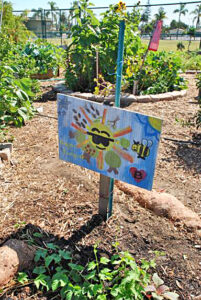You will want to plan the school garden to meet school and community expectations and arrange it to meet the requirements of those who will use it. Many elementary school gardens are designed so each class has a space allocated for planting vegetables and flowers. The size and shape of beds may vary according to space available and the number of students using each bed. In junior high-schools and high-schools, gardens are often assigned to a club as an extracurricular activity or to science classes as an outdoor laboratory. Small numbers of students may have a bed assigned for an experiment.
Use a team consisting of students, teachers, school administrators, groundskeepers, parent volunteers, and community representatives as a resource for suggesting ideas to be incorporated into the design. Prospective users: especially teachers, counselors, and the librarian can share what special functions they envision for the garden. Primary teachers may want a butterfly or pollinator garden. Other classroom teachers may desire a garden of edibles, native plants, a multicultural garden, or an orchard. A counselor may want a space for conflict resolution. Include someone to represent students who may have special needs. You will want to plan for those who may be wheelchair bound, have limited mobility, or be visually impaired. The committee’s recommendations will provide guidelines for those who will be implementing the design.
San Diego County’s climate offers opportunities for schools to develop a garden that will include blooming plants throughout the year as well as vegetables that will grow in each season. Including spaces for vegetables, annuals, biennials, and perennials will result in a beautiful year-round garden. Vines growing on trellises or arbors and permanent plantings of shrubs and trees will make the garden more attractive, but may also have invasive roots and shade growing areas.
Create a garden laboratory that is a pleasant place so student gardeners will be eager to return. Allow sufficient space to place art projects throughout the garden. Making space for art in the garden adds to the beauty, and provides an ideal place to display student projects. Murals, sculpture and other art forms will add interesting elements.
The balance of this section suggests topics for the planning team and the garden designers to consider as they select the site and design the layout.
